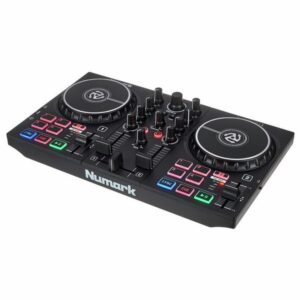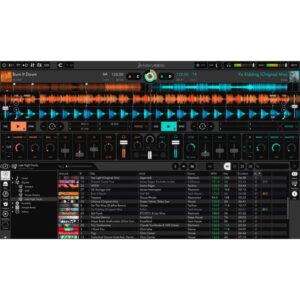It goes without saying that anyone who feels a calling to be a DJ should definitely know their music well. In addition to this, however, you need to have a feel for the audience and be able to entertain the crowd. After all, the DJ sets the tone of the party!
Hitting the right note as a DJ requires the right DJ gear and the following skills:
How to DJ – Buy a Controller
Although clubs mainly use CDJs and turntables, you should opt for a DJ controller first. These compact devices include a mixer and two decks with a jog wheel and pads that resemble the workflow of CDJs. For a price from about €250 upwards, DJ controllers offer all the features you need in a compact device that’s easy to take on the road.
The following DJ controllers are among the most popular in this price range:
- Native Instruments Traktor S4 MK3
- Numark Party Mix MKII
- Denon DJ Prime 4+ White
- Rane Performer
👉 Shop DJ Controllers 👈
How to DJ – Pick a software
Serato DJ, rekordbox, MixVibes, djay, or Traktor – every DJ software has its pros and cons. Which software you choose often depends on the DJ controller you buy. Most controllers are designed to work with specific software, which usually comes with the controller.
- MixVibes Cross DJ 4
- Native Instruments Traktor Pro 3
- Serato Studio
These so-called certified controllers are optimized for one or two specific programs and offer plug-and-play compatibility. However, most affordable controllers between €250 and €500 only include the Lite version of the software. Exception is, for example, Traktor S2 MK3 with a full license for Traktor Pro 3. So if you need the full version, you’ll mostly either need to get a slightly more expensive DJ controller or purchase an additional software upgrade.
👉 Shop DJ Software 👈
How to DJ – Drop a beat!
You are currently viewing a placeholder content from YouTube. To access the actual content, click the button below. Please note that doing so will share data with third-party providers.
The first step is to practise starting the beat of a new track on the “1”, the first beat of a 4/4 bar. To do this, use the jog wheel to find a bass drum and mark it with a hot cue. Have another track with the same BPM playing on the other deck. Now count four beats by triggering the hot cue pad or the cue button four times to the beat of the other track and start the new track by hitting the play button on the fifth count. Practise this until the beats line up neatly after each drop.
How to DJ – Align beats
Sooner or later, you’ll find yourself in a situation where you have to speed up or slow down a mixed-in track because the BPMs don’t line up exactly. This might happen, for example, if the Drummer played freely and not to a click. To practise this, use the technique described in the previous chapter. to layer two beats whose tempos are one or two BPM apart. If you hear an increasing double beat, use the jog wheel or pitch bend buttons to speed up or slow down the beat that is too slow or too fast until the beats line up again.
How to DJ – Match the beats
You are currently viewing a placeholder content from YouTube. To access the actual content, click the button below. Please note that doing so will share data with third-party providers.
In the age of DJ software that can automatically sync beats, the art of beatmatching has gone somewhat out of fashion. Nevertheless, you should never rely completely on the software, because even it can make mistakes. To practise beatmatching, do the following: Using headphones, start the track to be matched so that the bass drums of both tracks are initially exactly on top of each other. If the beats go out of sync, keep the beat to be matched in phase by using the jog wheel to bend the pitch. At the same time, slowly adjust its pitch control until you no longer need to use the jog wheel. Now the beats are matched.
How to DJ – Create a library
You are currently viewing a placeholder content from YouTube. To access the actual content, click the button below. Please note that doing so will share data with third-party providers.
What is your musical specialty and do you see yourself more as an all-round crossover DJ or as a music-specific artist? As an event and wedding DJ, it’s a lot easier to get booked. But you’ll need to have all the hits from the last 40 to 50 years in your repertoire – and the ability to combine them into an exciting set. DJs with artistic ambition, on the other hand, focus on a certain style of music that they exclusively represent. This approach doesn’t require as many tracks, but it can be more difficult to get the first gigs. No matter which direction you take, it’s best to sort your tracks in “Crates” by musical style or, for example, according to the energy of the track, or the timing of playback – e.g., WarmUp, PrimeTime, SlowDown, etc. This will make it easier for you to quickly find the right songs while DJing.
How to DJ – Master transitions
You are currently viewing a placeholder content from YouTube. To access the actual content, click the button below. Please note that doing so will share data with third-party providers.
To practise your first transitions, it’s best to use a track with an intro where only the beat is playing (no pitched instruments). Start the new track on the so-called downbeat (the first bass drum) at the beginning of a new section in the other track, e.g. the chorus, break-down, or outro. Use the EQ to filter out the bass frequencies from the track to be mixed in to prevent the low frequencies from adding up.
How to DJ – Use effects
You are currently viewing a placeholder content from YouTube. To access the actual content, click the button below. Please note that doing so will share data with third-party providers.
Every DJ software has a selection of effects, such as echo, delay, flanger, phaser, and reverb. You can use your controller to activate them. Their most important parameters include the adjustable beat length and intensity (dry/wet).
The echo effect is great for creating build-ups or ending a transition. To do this, set the beat length to ½ and 1. Flanger and phaser, on the other hand, are particularly suitable for break-downs with synth pads or synthetic string sounds. Select a beat length of four or eight beats. The reverb effect simulates the acoustics of a hall, which is best for break-downs.
We hope you enjoy DJing! Do you already have some experience as a DJ and want to share some tips with beginners? Let us know in a comment!























Comments 0
No comments yet.